Having a choice of top-quality effects pedals provides you with more options when it comes to creating unique tones with your guitar. Whether you require a subtle boost to emphasize a melody or you need spacey ambient effects to build tension, the single most effective way to achieve this is with pedals.
Effects pedals can be categorized into three different groups. You’ve got dynamic pedals like compressors, gain boosters, and limiters. Then there are timing pedals like delay, reverb, and chorus. Finally, we have the more extreme types of effects like distortion, phase, or wah-wah. Reverb pedals are, without a doubt, one of the most transformative additions you can make to your guitar rig.
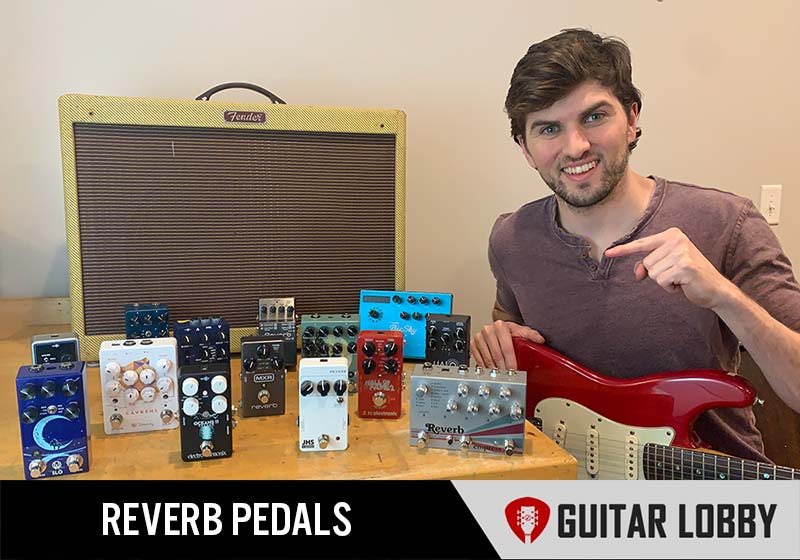
The great thing about reverb pedals is the versatility that they provide. Reverb is added to pretty much every instrument or vocal track in a recording studio to some extent. It can provide a subtle softness to a track, or alternatively, you can use it to make your guitar sound like it’s being played in a cathedral. In the following article, I’ll provide you with a comprehensive list of the best reverb pedals at each price point so that you can choose the right addition to your pedalboard. If you want to learn more about reverb pedals before jumping into reviews, check out our reverb pedal information guide at the bottom of the page here.
Table of Contents
- Here Are the Best Reverb Pedals
- 1. TC Electronic Hall of Fame 2 (Best Value)
- 2. JHS Series 3 Reverb (Best Under $100)
- 3. Keeley Caverns Delay Reverb (Best Reverb + Delay)
- 4. Empress Effects Reverb (Editor’s Choice)
- 5. Strymon Big Sky
- 6. Walrus Audio Slo Multi Texture
- 7. Electro Harmonix Oceans 11
- 8. Red Panda Context
- 9. MXR M300
- 10. Walrus Audio Lore Reverse Soundscape Generator
- 11. Walrus Fathom Multi Function Reverb
- 12. BOSS RV-6
- 13. Electro-Harmonix Holy Grail Nano
- Choosing the Right Reverb Pedal (Buying Guide)
Here Are the Best Reverb Pedals
1. TC Electronic Hall of Fame 2 (Best Value)
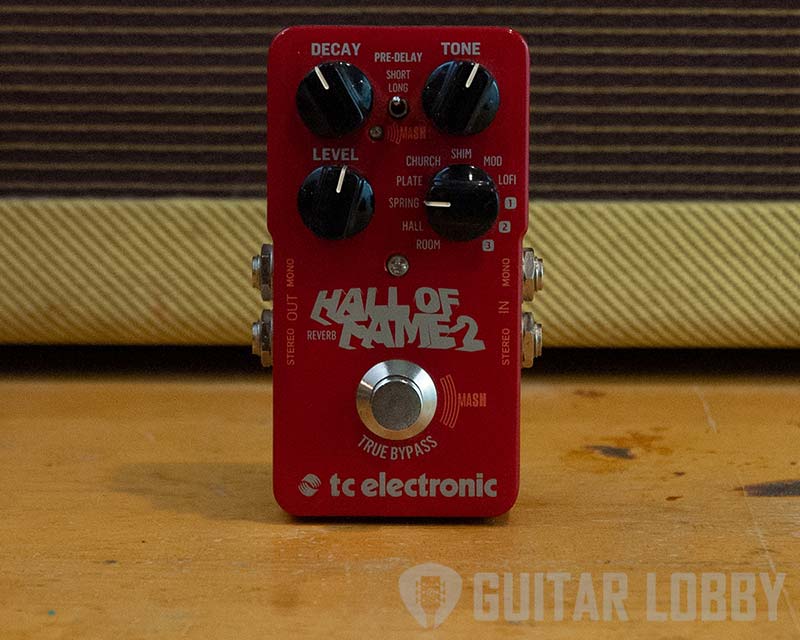
| Estimated Price | $160 |
| Power | 9VDC 100mA |
| Effects | Reverb |
| Connectivity | 2 x 6.35mm Jack Input, 2 x Output |
My Review: Initially released in 2017, the TC Electronics Hall of Fame 2 is still one of the most versatile reverb pedals out there. I own this pedal and use it on several of my pedal rigs. I have always appreciated the straightforward design of this pedal. It has the basic Level, Delay, and Tone controls we’re familiar with but also packs a range of preset reverb types, including customizable options via TC’s TonePrints app. The spring setting is one of my favorite digital interpretations of a classic spring box reverb. It allows you to get an incredible classic tone with a simplified control layout. Then the modes, such as Church and Shimmer, can give those lush glowing soundscapes that have become popular in many modern music subgenres. If I’m ever looking for something special and unique, the opportunities with the custom channels can be almost overwhelming at times.
I also really enjoy the brand-new shimmer reverb algorithm that takes your original signal, pitches it up by an octave, and then processes it through a feedback loop to produce a weird and wonderful tone. If you find a combination of reverb settings that you like the sound of, you can store up to three of your own custom presets using the dedicated TonePrint slots. Most other reverb pedals don’t have a comparable capability, and I’ve found this is really useful in live applications where I use unique reverb presets at different points during a set.
One of the biggest upgraded features of the Hall of Fame 2 from the original version of this pedal is the addition of the innovative MASH feature, which basically turns the footswitch of the pedal into an expression controller that reacts to the pressure that you apply.
When the on/off switch is compressed quickly, it operates as a typical stomp box switch turning the reverb control setting ON or OFF/Bypassed. When turned on, all of the pedal’s master settings are applied. The MASH feature is engaged by slowly compressing the on/off switch. Engaging the MASH feature bypasses the Level control and effectively becomes an expression pedal for controlling the amount of reverb you’d like to add to your signal.
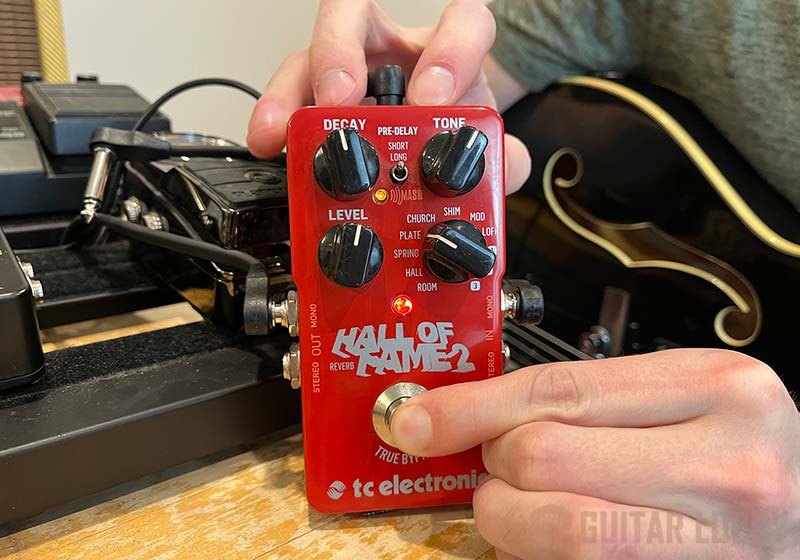
As I slowly engage the pedal footswitch, the “MASH” LED indicator will dim brighter the harder I press down. The lighter I press, the dimmer the MASH indicator LED, and the more subtle touch of reverb I’m adding to my signal. The harder I press the pedal, the brighter the MASH indicator LED, and the more reverb I’m adding to my signal. So essentially, if I press down hard enough that the light goes to max brightness, I have maximized the level of reverb effectively as if I turned the “Level” pot all the way up.
The only downside to this feature is the LED light intensity, which is only a rough indicator of how much reverb level you are adding. It can be tough to know exactly where you are in the range if it’s 4/10, 5/10, or 6/10. So I’ve found it’s not necessarily the easiest way to dial in a precise level. But in a live scenario, it’s still very useful to have the ability to vary the level of reverb you need with simple foot control.
Short of making room on your pedalboard and in your budget for a separate expression pedal setup, the MASH technology from TC Electronics is the best expression feature I’ve found in any pedal. In my personal use application of the HOF2, I typically have my reverb level set in place for whatever tone I’ve dialed in, and it stays ON almost 100% of the show. Then when there is a specific song or application I want to adjust my level, I will fade in the ballpark amount of reverb I want before reverting back to ON/OFF to go back to my base settings.
The TC Electronic Hall Of Fame 2 is a truly exceptional reverb pedal. With awesome classic and room reverb tones, as well as shimmering modern settings and the ability to download and store your own unique reverb settings, The HOF2 can do something for everyone and is one of the most versatile reverb pedals ever made.
Bottom Line: The Hall of Fame 2 is an incredibly versatile reverb pedal with impressive onboard presets as well as customizable channels. Straightforward controls and proprietary MASH pedal expression features make this one of the all-around best reverb guitar pedals available.
2. JHS Series 3 Reverb (Best Under $100)
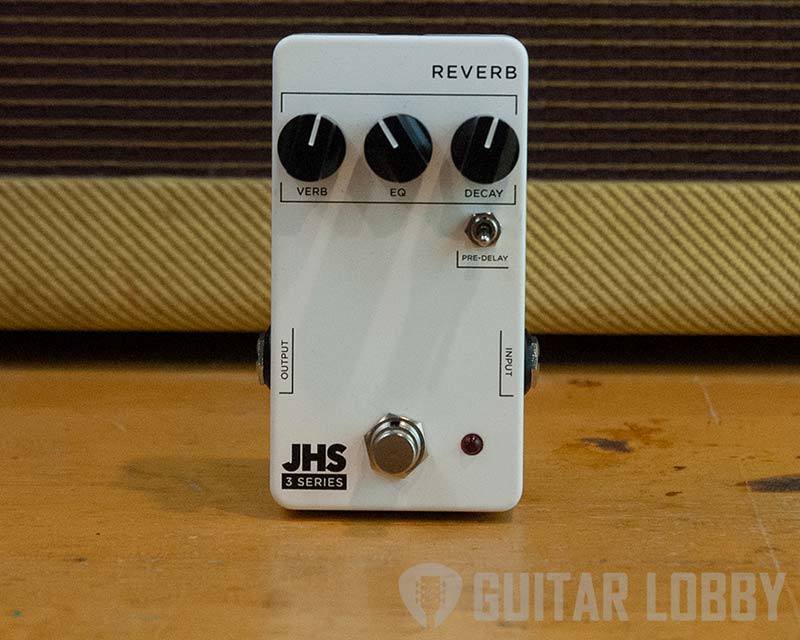
| Estimated Price | $99 |
| Power | 9VDC 100mA |
| Effects | Reverb |
| Connectivity | 1 x 6.35mm Jack Input, 2 x Outputs |
My Review: I am blown away by the value of this pedal. I love how warm and natural it sounds, and I really like that I can add depth and dimension with a reverb pedal without being overwhelming. JHS Series 3 Reverb pedal only has three simple yet powerful control knobs that make it quite versatile, considering its somewhat minimalist approach. This is a high-quality, versatile, and intuitive solution for adding reverb to your rig. One of the key controls is the Verb knob, which allows you to adjust the overall level of reverb in your signal. So I could use this to add a subtle hint of reverb to my sound or to create a more pronounced and immersive reverb effect that envelops my playing.
The second control is the EQ knob, which allows me to adjust the tonal character of the reverb effect. I found this useful to brighten or darken the reverb, to make it more pronounced, or to give it a more natural character. I found this particularly useful when I’m trying to fill the right space of my guitar into the overall mix of your song.
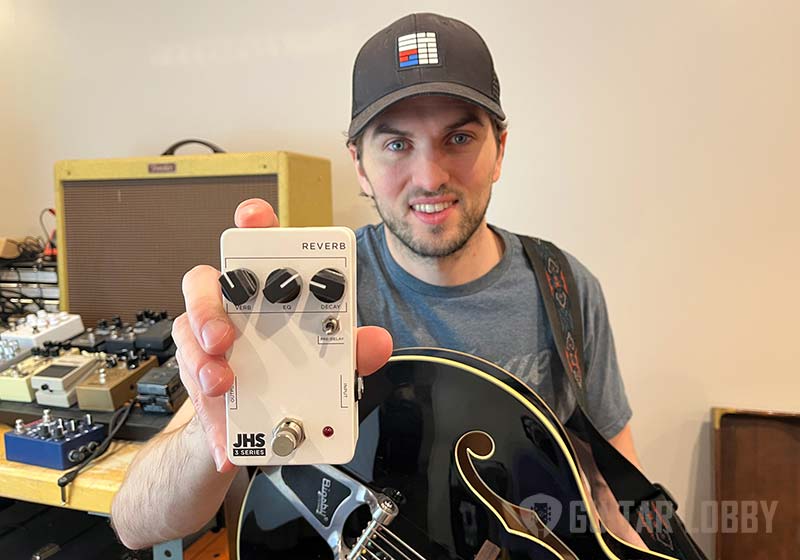
The Decay knob is pretty crucial, as it allows me to adjust the length of time that the reverb lasts. This can be used to create a shorter reverb that only lasts a few milliseconds or a longer reverb that lasts several seconds. This control is particularly useful for me to dial in a cavernous reverb for an ambient piece or a short or if I want to dial things down to just fatten up my tone.
In terms of how it is best utilized, the JHS Series 3 Reverb is perfect for any musician looking for a simple design with few simple yet useful features.
Bottom Line: A minimalist design at an affordable price. This pedal is easy to use and boasts reverb tone control that sweeps from bright and shimmering to dark and textured. Another great value, this is one of the best reverb pedals for under $100.
3. Keeley Caverns Delay Reverb (Best Reverb + Delay)
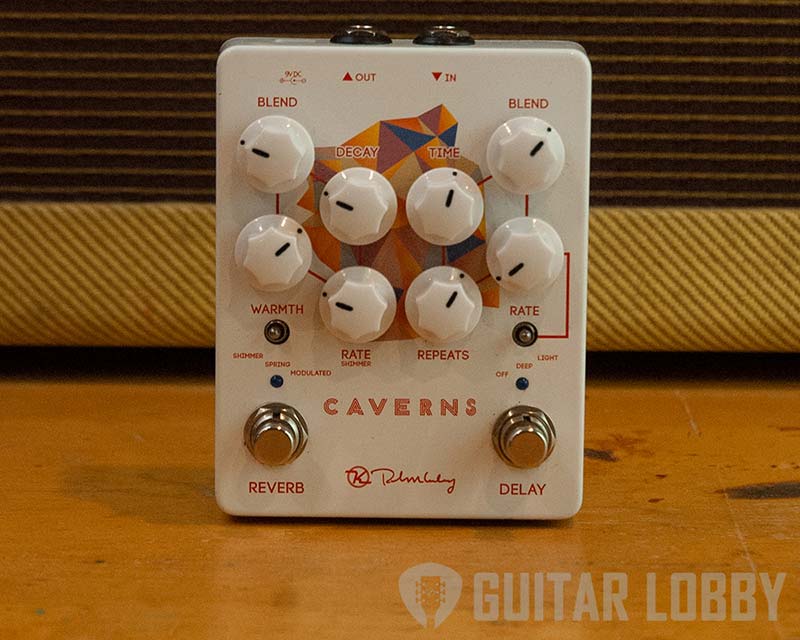
| Estimated Price | $200 |
| Power | 9VDC 100mA |
| Effects | Reverb & Delay |
| Connectivity | 1 x 1/4″ Input, 1 x 1/4″ Outputs |
My Review: This is one of my favorite reverb pedals I’ve ever played. The Keeley Caverns is both a Reverb and Delay effect in one intuitively laid out design. I realized why this pedal is so popular the first time I experienced the awesome multi-texture reverbs this pedal packs. Whether I’m creating mellow soundscapes, a more modern digital sound, or looking for a classic blend, this pedal shines for me in just about every category.
The “Shimmer” reverb setting is lush and open, perfect for room-filling soundscapes. The “Spring” setting is a much more classic spring box reverb tone, similar to what I’m used to and use most often. The “Modulated” setting was interesting as it has a bit of a chorus effect layered in.
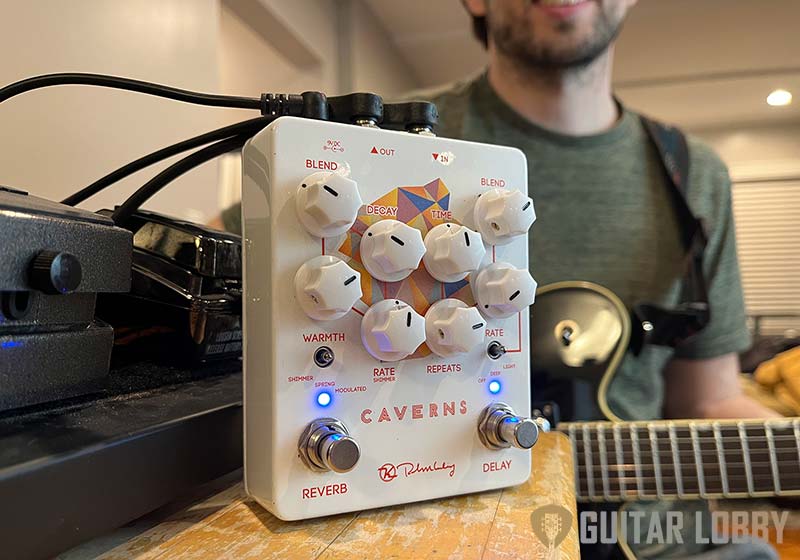
One of my favorite design features on this pedal is the double blending knobs. My personal pedalboard usually includes a versatile reverb pedal and an analog delay pedal. I am typically very conservative with reverb. It depends on the pedal or amp setting, but generally, I set up right around the 2 / 10 mark. As for my analog delay setting, for most applications, is set to a relatively low time interval with moderately low repeats. I’m looking for more of a quick, subtle “echo” to make my notes full rather than a pronounced repeat of notes. At times I really enjoy the ability to get a really drenched delay effect but blend in just that touch of reverb as well. So working to find that perfect blend of reverb and echo effect with two different pedals is common for me in most scenarios. The Caverns pedal makes it easy to dial in that sweet spot of a blend that I’m so often looking for.
I found the controls and overall design of this pedal very intuitive and fun to experiment with and explore the tonal opportunities with some of Keeley’s delay tones. I would say there is one potential downside to this pedal. If you are just looking for a Reverb effect, there are some more straightforward solutions on the market than this blended Reverb/Delay pedal. Digital delay effects, in general, can be a bit of a learning curve if you are not the type of player who dabbles with them often in your playing. So if you are more of a blues and classic rock player who just wants a classic Reverb effect, then the Caverns may slightly overcomplicate things for you.
Bottom Line: The Keeley Caverns V2 offers players a Reverb/Delay combo. It is versatile, easy to use, and has some unique features that set it apart from other pedals in its class.
4. Empress Effects Reverb (Editor’s Choice)
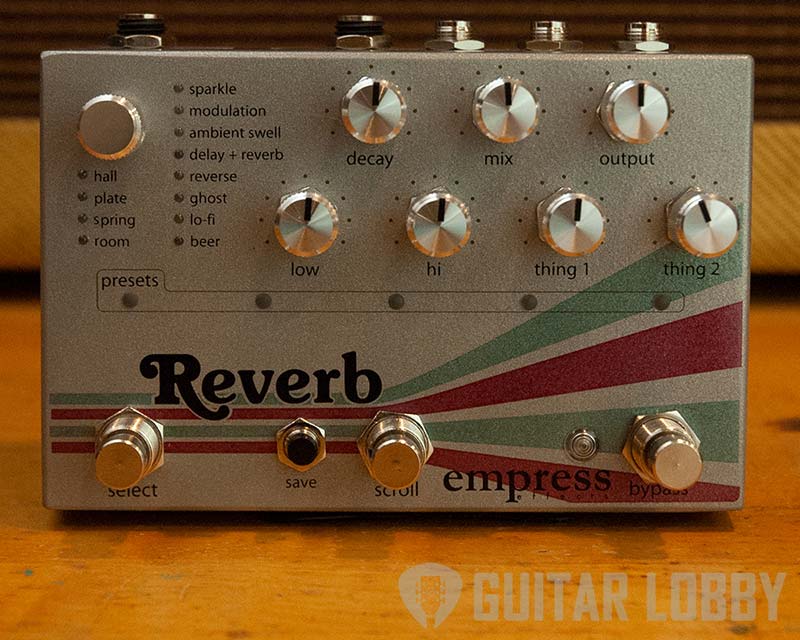
| Estimated Price | $500 |
| Power | 9VDC, 300mA |
| Effects | Reverb |
| Connectivity | 2 x 1/4″ (L/mono, R) input, 2 x Output, 1 x 1/4″ MIDI control, 1 x SD card slot |
My Review: I have had the pleasure of trying out nearly every reverb pedal on the market. I have to say; the Empress Effects Reverb Pedal truly rivals any reverb pedal available. This pedal really shines with its plethora of modern, unique, and highly customizable reverb effects, but I also cannot understate just how much I love the more classic Spring, Plate, Hall, and Room settings as well. Each classic setting is rich and lush, warm and natural, and the decay is smooth and gradual, giving your music a sense of space and dimension.
This pedal rivals my Strymon BigSky in every way. What the reverb pedals in this high-end category really offer that the majority of Reverb pedals can’t compete with is a ridiculously wide array of algorithms, controls, and presets to experiment and create unique washed ambient soundscapes. Interestingly enough, though, I gave a slight edge to the Empress Reverb and ranked it one spot above my Stryman BigSky because I personally find myself slightly preferring the feel of the more classic settings, particularly hall and spring, of the Empress compared to the BigSky. I found the two fairly equally capable of crafting unique atmospheric textures, and although the Strymon has more preset channels, both pedals had more than enough preset channels for my needs.
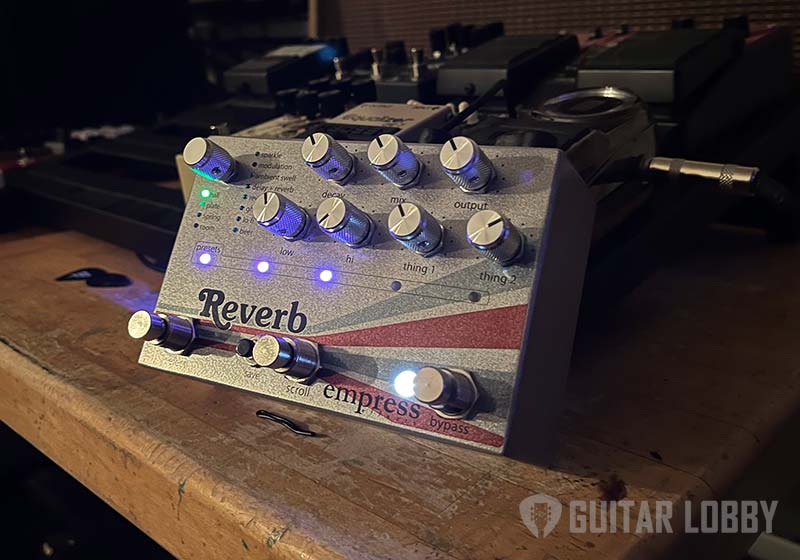
While pedals such as the Empress Reverb, Strymon BigSky, and Evident Space have carved out a niche market category of their own, one thing to consider for many guitarists is that there is often a bit of a learning curve that may be suited for a more expert-level player to really utilize all it has to offer. The kind of player who has the time to experiment and fine-tune unique soundscape effects and take advantage of the plethora of preset channels will get the most out of this pedal. That being said, for a more intermediate or beginner-level player, the Empress Effects Reverb Pedal is sure to have some high-quality reverbs for you to easily dial in and save a few presets and enjoy the high quality of this pedal as well. have carved out a niche market category of their own, one minor downside for many guitarists is that they also sometimes have a learning curve that may be suited for a more expert-level player to really utilize all it has to offer. The kind of player who has the time to experiment and fine-tune unique soundscape effects and take advantage of the plethora of preset channels will get the most out of this pedal. That being said, for a more intermediate or beginner-level player, the Empress Effects Reverb Pedal is sure to have some high-quality reverbs for you to easily dial in and save a few presets and enjoy the high quality of this pedal as well.
Another thing to consider is the power supply needs of this pedal. A power supply is not provided, and the Empress Reverb requires a minimum of 300mA from a 9VDC source. While there are plenty of technological design advantages one can expect from this pedal in exchange for this minor inconvenience, it is worth noting to buyers that you will need to consider the ability of your power supply to accommodate this pedal or others like it, such as the Strymon BigSky which also requires 300mA from a 9VDC source.
Bottom Line: Absurdly good digital reverb packed with high-quality and customizable ambient effects as well as classic reverb types that have a smooth analog feel.
5. Strymon Big Sky
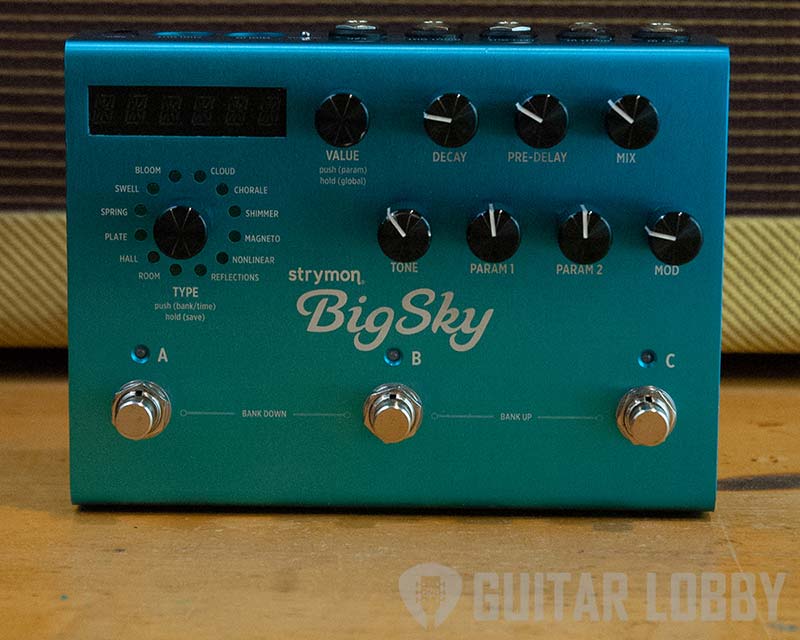
| Estimated Price | $500 |
| Power | 9VDC 300mA |
| Effects | Multi-Effects |
| Connectivity | 2 x 6.35mm Jack Input, 2 x Output |
My Review: The Strymon BigSky reverb pedal is a fan favorite. I’ve owned this pedal for a couple of years now and started using it, for a period of time, in place of my HOF2 as a pedal that can deliver the excellent analog vibe of the more classic settings while still allowing me to save and carry some more washed ambient tones to my gigs. For most of my personal playing needs, I tend to use the more traditional Spring, Plate, and Hall setting for the bulk of my playing. However, for certain applications, such as a wedding service, I like to use more atmospheric washy reverbs. I’ll be the first to admit that I don’t make use of anywhere near all of the BigSkys preset channels. It has more banks and versatility than I will likely ever need. With 100 preset channels and three presets per channel, giving the guitarists 300 total presets, this reverb machine is highly customizable and delivers breathtaking tones.
This pedal takes some time to explore all that it’s capable of doing, but you will find algorithms that produce rich, lush, and immersive soundscapes. From smooth and ambient hall reverbs to dreamy plate reverbs, the BigSky has a reverb tone for every occasion. One of my favorite modes on this pedal was the “shimmer” mode which adds a beautiful high-octave overtone to my reverb, giving me the ability to create some truly unique soundscapes.
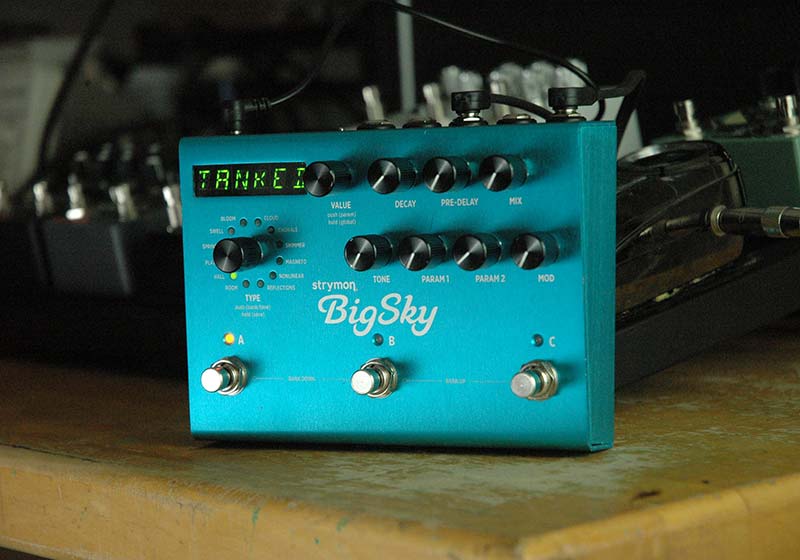
The BigSky also features a number of unique and high-end features that I find useful on a regular basis. For example, the pedal has a “freeze” mode that allows you to hold the reverb sound in place, giving you the ability to play over it like an instrument. I also make use of the “resonant tails” feature, which I find adds a level of depth and sustain that few other reverb pedals offer. Much like the Empress Reverb discussed before, we are in an advanced-level reverb generator with features that simply set it apart in a niche upper class of reverb pedals with little competition.
Also discussed previously, this is another pedal with higher current demands from a power supply. Although Strymon will provide a power supply, if you want to use your pedal board supply, you will need to allocate space for a 300mA plus output. In terms of cons, really, the only other thing to talk about is price. This high-end reverb pedal can best be compared with the Empress Reverb and Evident Space, which will be similarly priced.
Bottom Line: A comprehensive digital reverb machine that can model analog tones exceptionally well. Offers settings for more classic reverb types but really shines as an ambient sound box with seemingly limitless possibilities. With the BigSky reverb from Strymon, the sky really is the limit.
6. Walrus Audio Slo Multi Texture
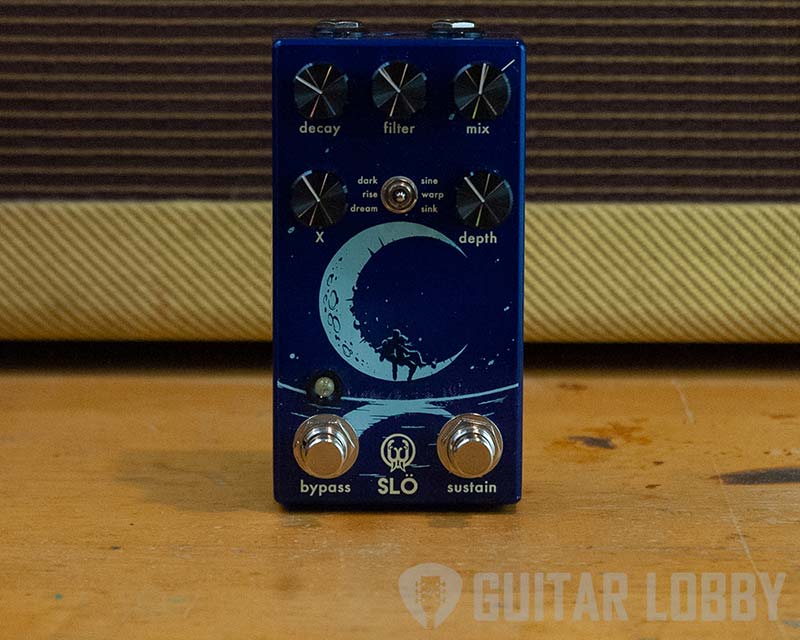
| Estimated Price | $200 |
| Power | 9VDC 100mA |
| Effects | Reverb, Modulation |
| Connectivity | 1 x 6.35mm Jack Input, 1 x Output |
My Review: Walrus Audio is fast becoming one of the leading producers of guitar FX pedals, and the Slo Multi Texture is one of my favorite pedals they’ve ever produced. One of 3 pedals on this list that I use on my personal pedalboards, this one gives me access to smooth, ambient soundscapes and has a somewhat unique ability to produce textural reverb. With three onboard algorithms that have been specifically designed to bring the dreamy reverbs of your imagination into sonic reality, the Slo Multi Texture boasts impressive depth.
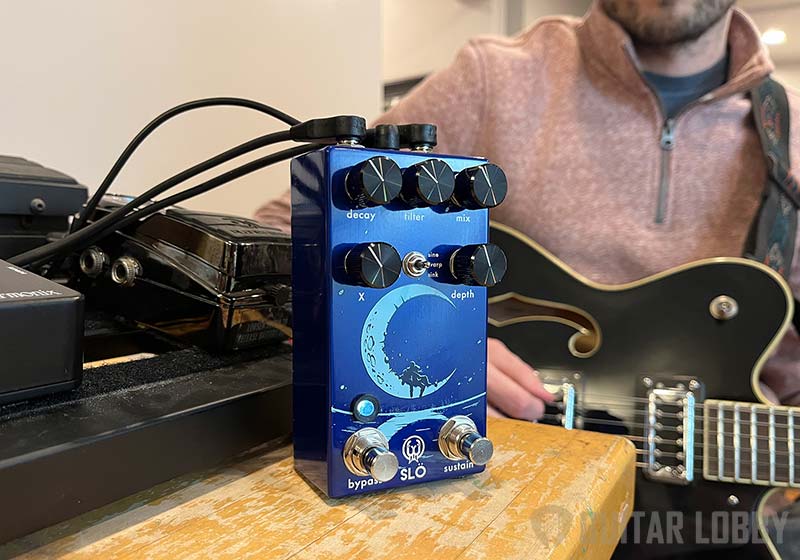
The three modes can be alternated using the toggle switch. There’s the “dark” mode which is best suited to lower octaves, and the “rise” mode which creates ambient swells of reverb. There is also the “dream” mode, which resembles a latching pad. The secondary functions of the switch give you access to various wave shapes so you can modulate the tone and characteristics of your chosen reverb setting.
Dark mode has to be one of my favorite features on this pedal. It adds a lower octave to your reverb trail, which I love how it makes my clean tones sound absolutely huge! I’ve found this pedal most integral to a rig setup for playing those big, room-filling, atmospheric soundscapes that I use extensively with a couple of the groups I play with. That’s really what this pedal does best, and rivals any other reverb on the market for that purpose. On the other hand, a drawback to this particular pedal is that there are likely other options to consider if you are looking for more of a “classic” reverb effect.
Rise mode is a “swell” reverb which can be great for a slow rise and fall, or I like to dial in sometimes a much more subtle mix with a gentle swell to trail behind my playing. The X knobs allow you to control the amount of time it takes the swell to rise and fall, while depth gives us the control to increase or decrease modulation. I personally haven’t used rise mode nearly as much as Dark mode, but it’s quite nice. I’d describe it as more soothing.
Another feature I find useful is the sustain switch which can be used to capture a section of your guitar’s input, freeze it, and create a pad-like reverb from the original audio. I’m a huge fan of using your own sounds to create effects, and it’s quite rare for this to be possible using a standard stompbox-style pedal without connecting to a DAW. You can also let the reverb taper off gradually by tweaking the position of the decay knob.
Who’s it best suited for? Guitarists who love to create dreamy ambient soundscapes will absolutely love the Walrus Audio Slo Multi Texture pedal. If you play textural melodies or pad sounds, then this is the perfect pedal for you.
Bottom Line: This Walrus Audio reverb pedal is unique because it goes beyond the standard settings featured on most stompboxes. Although it doesn’t provide you with conventional types of reverb, it produces a brilliant array of ambient tones that are perfect for creating space within your guitar tracks.
Popular Related Article: 17 Best Delay Pedals (Digital and Analog)
7. Electro Harmonix Oceans 11
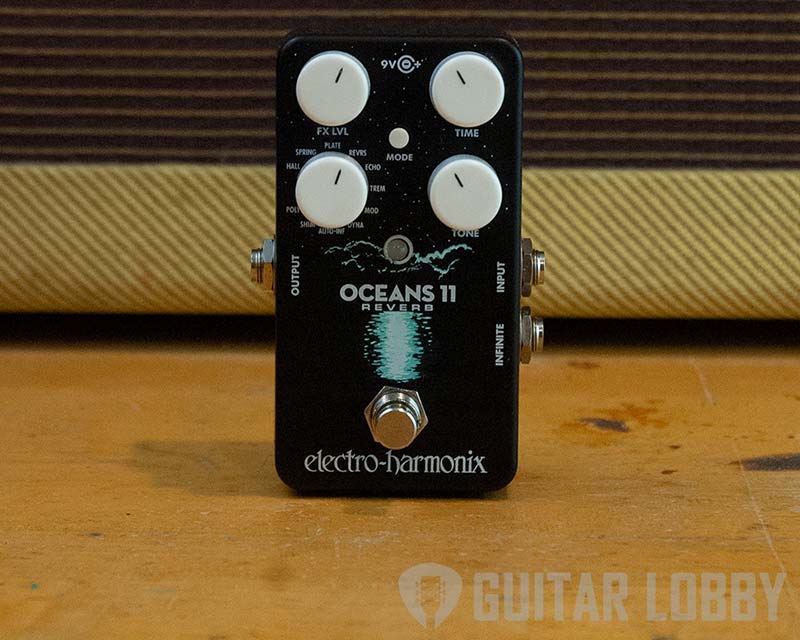
| Estimated Price | $180 |
| Power | 9VDC 150mA |
| Effects | Reverb, Tremolo, Modulation |
| Connectivity | 1 x 6.35mm Jack Input, 2 x Output |
My Review: I consider this to be a highly versatile option, ideal for creating experimental reverb soundscapes or simply adding a touch of decoration to your guitar. The Oceans 11 by Electro Harmonix is a brilliantly detailed stomp box containing 11 individual reverb settings. In terms of similar products, I consider the Oceans 11 to rival the TC electronics HOF2.
Along with the extensive number of reverbs with this pedal, it also has a handy tail witch which controls the sustain of the effect after you’ve hit the true bypass switch. I like this feature for making smoother transitions and a more consistent fade-out that doesn’t sound artificial.
Let’s take a closer look at the specific reverbs available with the Oceans 11. Firstly, you get the standard group of spring, plate, and hall settings, perfect for creating classic reverb undertones to merge with your clean tone. I think very highly of the classic spring reverb setting on the Oceans 11. The spring reverb effect is very important to me as it’s the type of reverb I’m looking for most often, so the spring setting alone on this pedal was enough to earn it a spot near the top of the list. The other variations have been highly compatible with my other FX pedals, like distortion, due to their subtle nature. If you want to produce more extreme forms of reverb, you can use the reverse, modulated, and dynamic modes. These ambient effects each sound unique, inspiring you to innovate with the pedal.
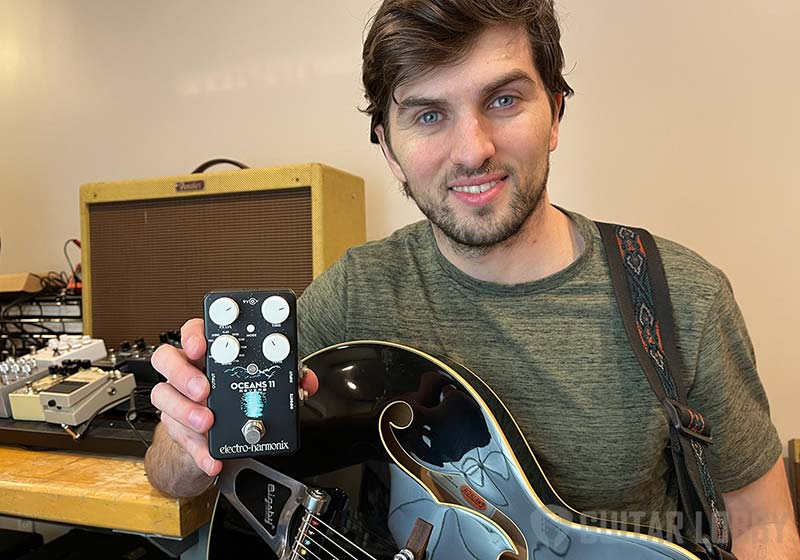
What I find sets this pedal apart from others is the “INFINITE” feature which allows you to sustain and crossfade to a new reverb wash. The Oceans 11 has a dedicated input jack that can be used to manually control the INFINITE features as well as an auto-infinite effect which will auto crossfade to a new reverb wash upon detection of newly struck notes and chords I found the particularly interesting. This works by triggering a wash when you play a note or chord, creating pad-like, atmospheric reverbs to add thick layers to your tracks. Each of the settings can be tweaked to your liking using the depth, tone, and duration controls on the face of the Oceans 11 pedal.
While the INFINITE feature certainly adds useful utility to your pedalboards, I’ve found it can be difficult to get the “auto-inf” to work at maximum effectiveness unless I’m playing something with long delay intervals. It’s great for playing big room-filling soundscapes. The pedal will sustain a drenched reverb note indefinitely until you play a new note or chord, then crossfade into a new wash. It will certainly take you some practice and experimentation to see what you are capable of doing with the feature, but it is somewhat unique. You’ll likely only find a few pedals that have something even comparable such as the sample and hold feature on the Keely Canyon.
I’m always impressed by the build and sound quality of Electro Harmonix guitar pedals, and the Oceans 11 reinforces this notion for me. This is a highly detailed pedal that produces a seemingly infinite number of spacey reverbs and is guaranteed to interact well with the other pedals on your board.
This pedal is best suited for musicians who like to create atmospheric, spacey layers of reverb and have time for experimenting with the comprehensive set of controls on the Electro Harmonix Oceans 11. If you have some experience with pedals, this option provides you with a step up in quality.
Bottom Line: Versatile reverb that includes excellent classic spring reverb tone as well as big spacey, shimmering, and layered reverb options. and innovative auto-Infinite
8. Red Panda Context
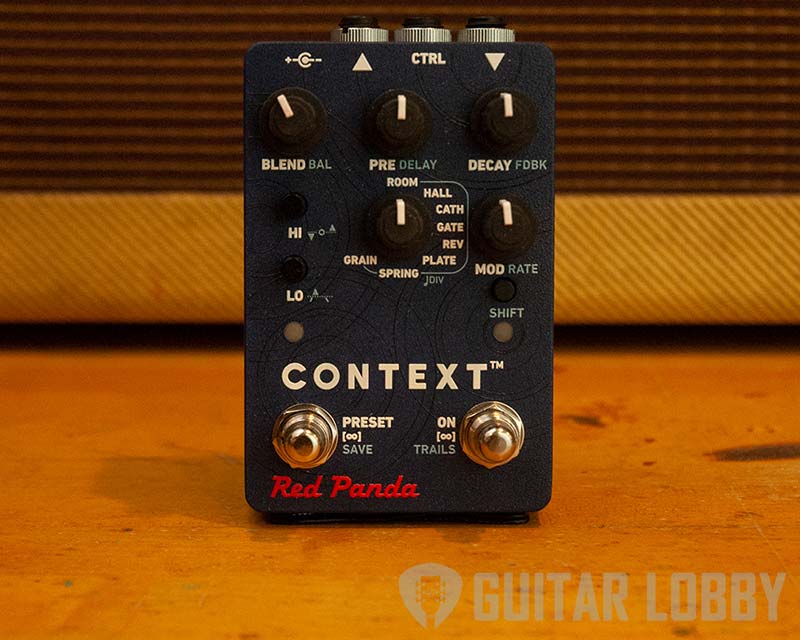
| Estimated Price | $330 |
| Power | 9VDC 250mA |
| Effects | Reverb (+Delay) |
| Connectivity | 2 x 6.35mm Jack Input, 2 x Output |
My Review: I loved experimenting with this one! The Red Panda Context Reverb pedal is a relatively recent discovery for me, and I must say, I am impressed. It’s a digital reverb pedal that provides a wide range of options, from familiar classic spring and hall reverbs to more experimental sounds like reverse, and non-linear reverbs and digital delays. What makes this pedal unique is its ability to generate reverb based on the input signal. Based on the input signal, the pedal generates reverb based on the note, chord, and rhythm of the playing. This results in a more organic and natural sound, as opposed to the typical reverb sound which I’ve found can often sound static and artificial. When using this pedal, I love that I can dial in something subtle and understated, or I can go for something bold and lush, making it very usable for a wide range of musical styles.
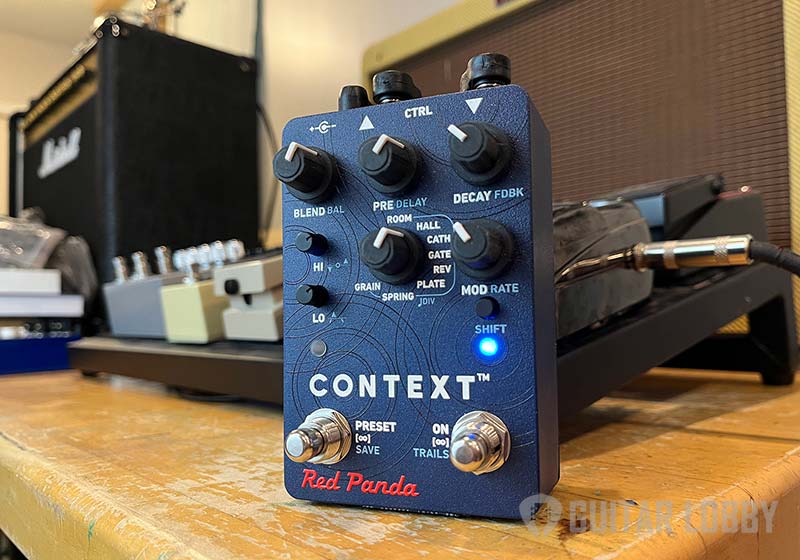
The build quality of the Red Panda Context Reverb is also impressive. The pedal is housed in a compact, durable metal enclosure and features true bypass, ensuring that the input signal is not altered when the pedal is not in use. The knobs and switches are solid and feel great to the touch, and the pedal is easy to use.
I have used this pedal in a number of different musical settings over several months, and it has consistently delivered great results. The pedal is especially well suited for ambient, experimental, and experimental rock, but it can be used in any musical style that requires reverb. The Red Panda Context Reverb is a must-have for any guitarist who wants to add depth and dimension to their sound. Its unique and versatile sound, combined with its solid build quality and ease of use, make it one of the best reverb pedals on the market.
Bottom Line: All the classic reverb algorithms you love but with a modern spin. This is an excellent boutique pedal with top-notch build quality and is packed with features for those looking to dial up something a little bit unique.
9. MXR M300
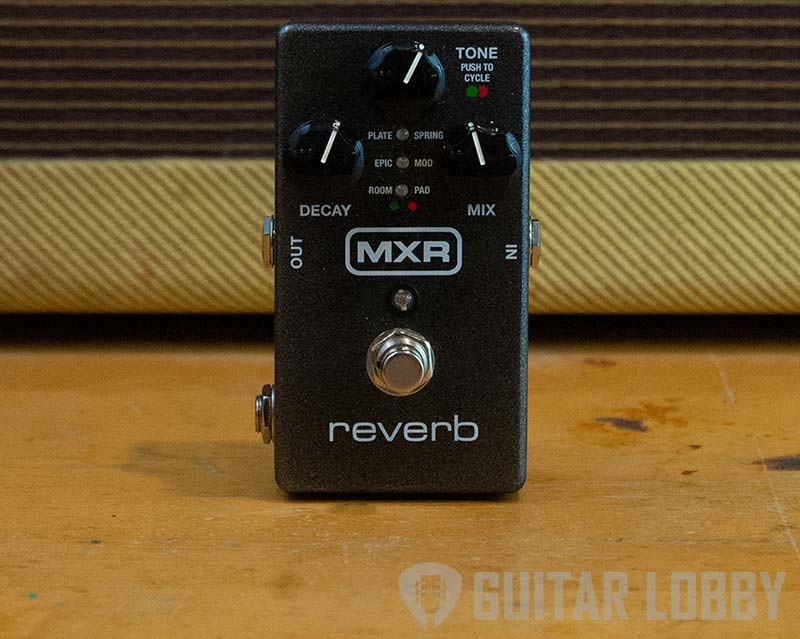
| Estimated Price | $220 |
| Power | 9VDC 100mA |
| Effects | Reverb |
| Connectivity | 1 x 1/4″ Jack Input, 2 x Outputs |
My Review: The MXR M300 pedal produces six individual reverb styles ranging from classic spring to room and hall, each meticulously designed and crafted by renowned MXR designers. Despite its extensive range of sonic options, the M300 is housed in a compact, standard-sized pedal that is laid out in an easy-to-navigate style. I appreciate how easy this pedal is to use. I’ve been using it pretty regularly for a few months now, and it’s held up well despite my tendency to be a bit rough with my gear.
The M300 has MXR’s innovative Constant Headroom Technology. With 20 volts of headroom, I love how this pedal performs with clarity at a wide dynamic range. Whether I’m using the classic spring reverb or the more modern plate reverb, I always feel like I’m always getting a reverb that is rich and warm, and it never feels artificial or over-the-top. I especially enjoyed using this reverb with my overdrive pedals, as it really adds a nice depth to my tone. One of my favorite modes was MOD mode, which has a subtle chorus effect that gives the reverb a warm and organic feel.
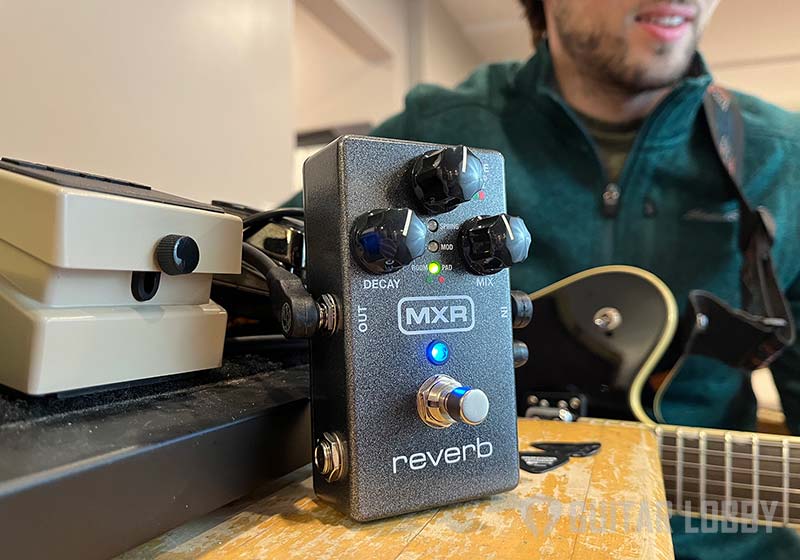
I also really appreciate that each of the reverb styles is very similar in quality to the top-rated plug-ins or rack units. The plate setting gives you a smooth, spacey reverb that shimmers like an authentic sheet of metal. The spring setting accurately recreates the reverb found in high-end valve amplifiers. Then there’s the epic setting, which combines analog delay with modulation effects. You can easily toggle through these reverb settings by pushing the tone control, and with two outputs, this pedal can be used to split the dry/wet single into multiple amps.
There are a lot of options for reverb pedals, and this one certainly lacks some of the higher-end control features and customization options that other units offer. That being said, sometimes all you need is a high-quality, reliable, and simple-to-use reverb effect. I feel like the versatility and sound quality of the pedal makes it worth every penny at this price point. I’ve used cheaper pedals in the past that just don’t sound as good as the MXR M300, so I feel like it’s been a good value investment for my rig. Whether you’re a seasoned player or just starting out, I think you’ll be impressed with what the MXR M300 has to offer.
Bottom Line: The MXR M300 reverb is easy to use, well-built, and sounds fantastic. Versatile enough to cover all your basic reverb needs with high-quality tones while remaining free of complicated features most guitarists will likely not have a need for.
10. Walrus Audio Lore Reverse Soundscape Generator
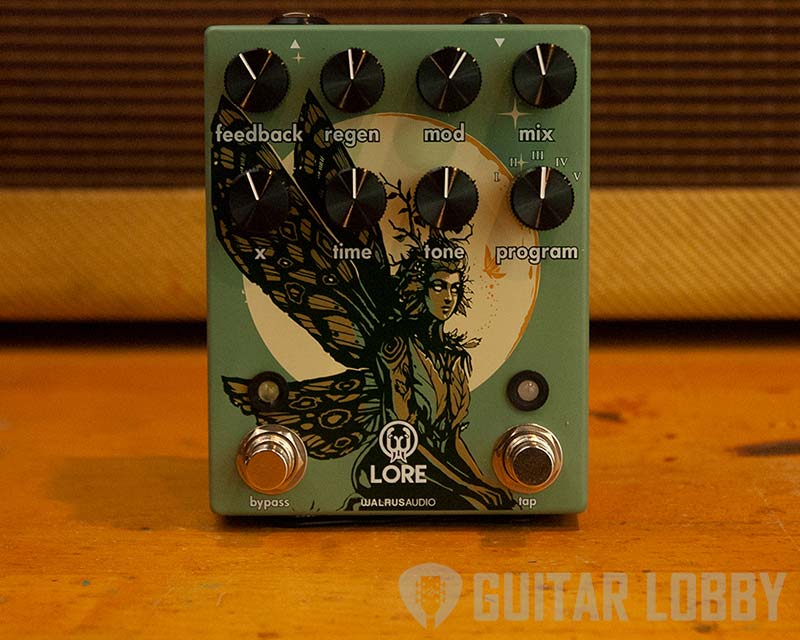
| Estimated Price | $299 |
| Power | 9VDC 300mA |
| Effects | Reverb, Delay |
| Connectivity | 1 x 6.35mm Jack Input, 1 x Output |
My Review: The team at Walrus Audio recently introduced me to their Lore Reverse Soundscape Generator reverb pedal. This is a relatively new product in their lineup that they are excited about, which naturally had me intrigued to get my hands on one. When I first plugged the pedal in, I quickly found it to be different than any other reverb pedal I had been accustomed to, which has made me excited to experiment with new sounds and see how it could enhance my tones.
The build quality of the Lore Reverse Soundscape Generator is solid and well-designed, with a sturdy metal casing and clear labeling of all the controls. Walrus seems to have a knack for making stompboxes that go heavy on building washed reverb tones. In this case, the lore offers different combinations of reverse effects and pitch manipulation controls. What makes this pedal different from others like it is that it is designed with two circuits, one feeding back into the other, which allow signal paths to interact.
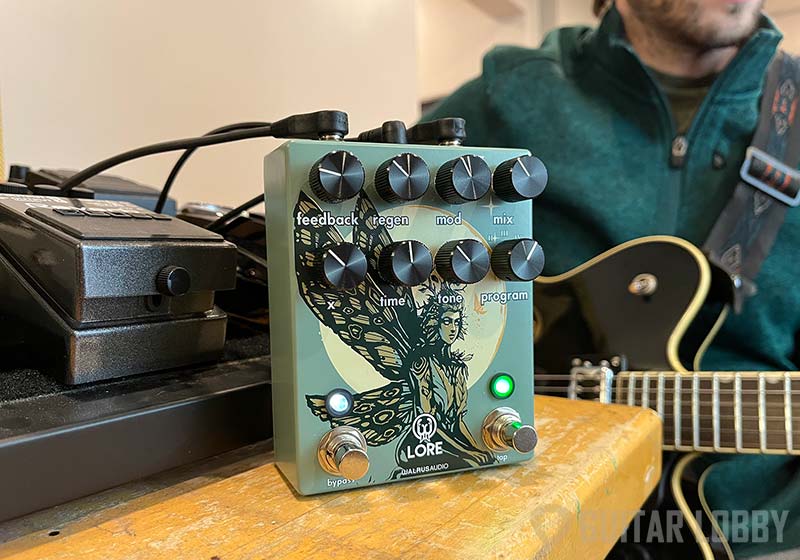
The reverse reverb effect is truly something different and special. It takes some time to get used to, but the possibilities are really inspiring. This pedal is best for players looking to create washed atmospheric effects, perfect for creating unique soundscapes. I found that the reverse reverb effect works especially well with delays and other modulation effects. It creates a dreamy, haunting sound that can add a whole new dimension to your playing.
Bottom Line: The Lore is a modern soundscape generator that offers the rather unique ability to blend two signal paths, a reverse delay or reverb, into a forward reverb or pitch shift.
11. Walrus Fathom Multi Function Reverb
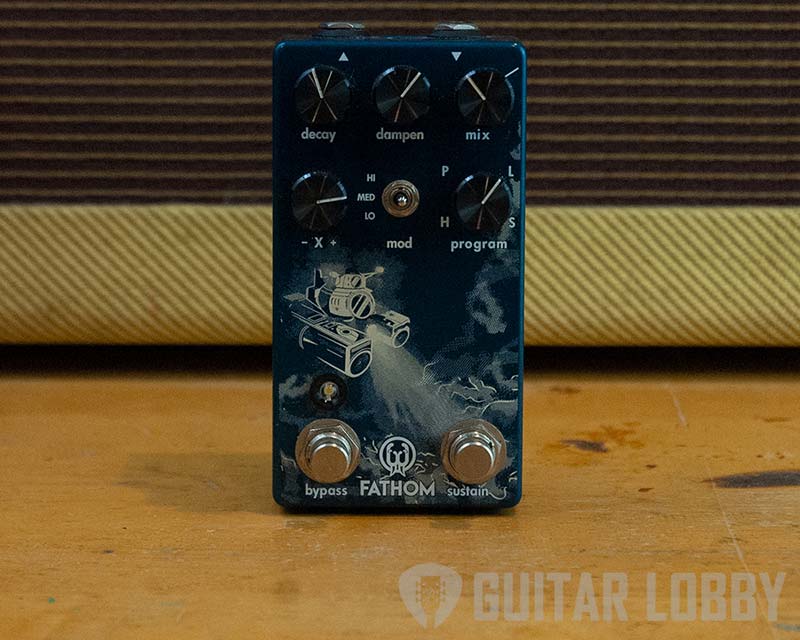
| Estimated Price | $200 |
| Power | 9VDC 100mA |
| Effects | Reverb |
| Connectivity | 1 x 6.35mm Jack Input, 1 x Output |
My Review: I decided to rank both the Walrus Fathom Multi-Function Reverb as well as the Walrus Audio Slo Multi Texture on this list as I couldn’t bring myself to truly only choose one. I personally own and have gigged with the Slo but believe many guitarists might prefer the Fathom. When it comes to creating dreamy modern ambient reverbs, Walrus audio has some of the best pedals available on the reverb pedal market today. Just as the previously discussed Walrus pedals, the Fathom also has a wide range of tonal options to choose from. You certainly can dial this pedal down for a much more simple, organic, natural-sounding reverb, but the Fathom is best suited for modern, creative, and digital soundscapes that will fill the room.
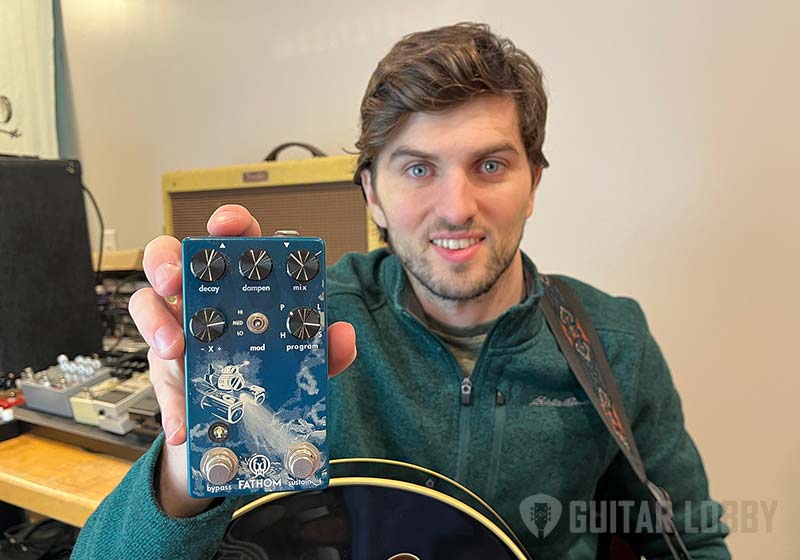
One thing I appreciate about the fathom is its simple but useful four-base reverb algorithms, each providing distinct sounds and characters. The ‘H’ setting emulating a Hall reverb delivers a rich and spacious reverb, while the ‘P’ setting emulates the classic plate reverb. The ‘L’ setting is perfect for creating a vintage or degraded reverb, and the ‘S’ setting offers a unique modulated reverb effect.
In addition to the different algorithms, the Fathom also offers six adjustable knobs that provide precise control over the reverb sound. The ‘Dampen’ knob adjusts the high-frequency damping, while the ‘X’ knob adjusts the pre-delay time, which I find particularly useful. The ‘Mix’ knob allows for control over the balance between the dry and wet signal, while the ‘Size’ knob adjusts the size of the virtual space in which the reverb occurs. The ‘Depth’ knob provides control over the modulation depth, and the ‘Rate’ knob adjusts the modulation rate.
The Fathom is yet another incredible reverb pedal from Walrus Audio that really shines at washy tones and ethereal soundscapes.
Bottom Line: A versatile and innovative device designed for musicians looking to create unique, high-quality atmospheric textures.
12. BOSS RV-6
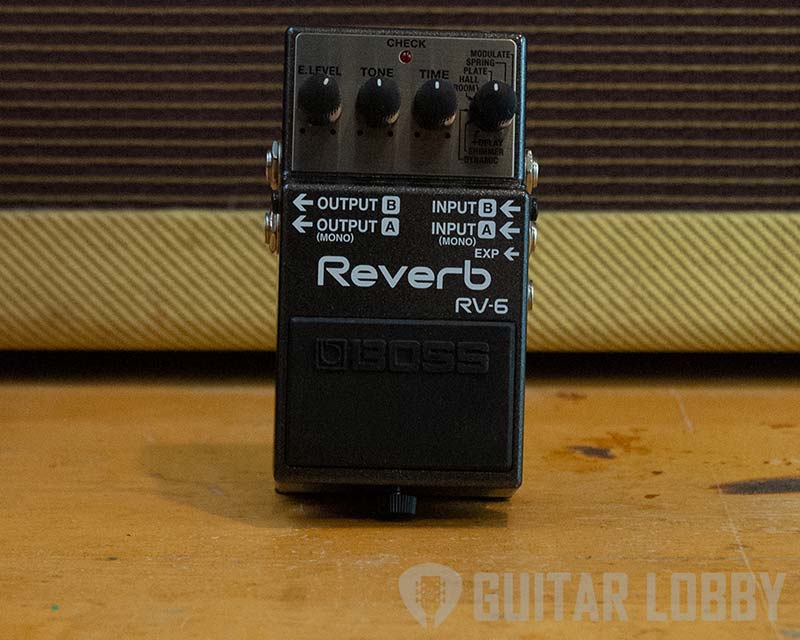
| Estimated Price | $170 |
| Power | 9VDC 100mA |
| Effects | Reverb |
| Connectivity | 2 x 6.35mm Jack Input, 2 x Output |
My Review: I’ve been testing the BOSS RV-6 reverb pedal, among other pedals in this article, for a few months now, and I have to say I’m thoroughly impressed with its performance. The controls are intuitive, and the knobs are clearly labeled, making it a breeze to dial in the perfect reverb tone. Whether I’m looking for a subtle room reverb or a more dramatic hall reverb, the RV-6 delivers. I also appreciate the presence control, which allows me to adjust the high-end frequency response of the reverb to my liking.
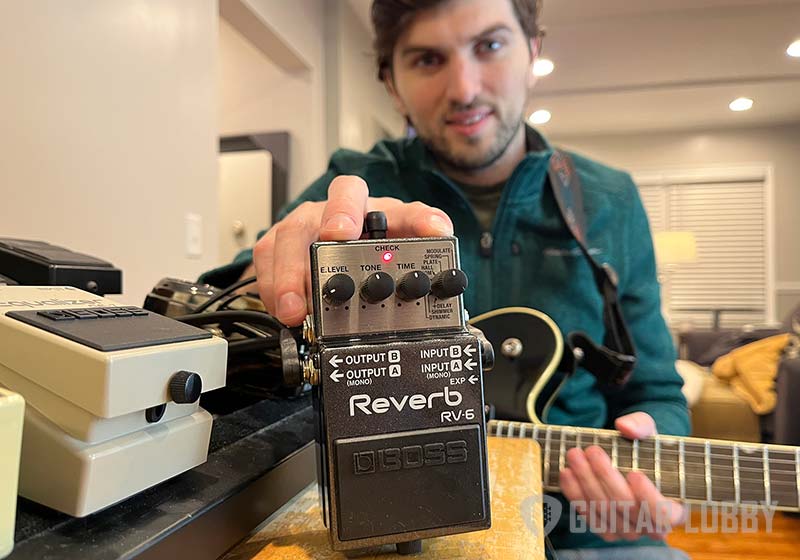
Another thing I appreciate about the RV-6 is the build quality. The RV-6 is also built to last. It has a rugged metal chassis that can withstand the wear and tear of regular use, and the pedal switch is smooth and responsive. I also like that it’s compact and lightweight, making it easy to transport to gigs, rehearsals, or working into my studio rig.
Bottom Line: The BOSS RV-6 reverb pedal checks all the important boxes with a full range of settings, intuitive controls, and rugged construction, making it a great choice for players of all levels and styles.
13. Electro-Harmonix Holy Grail Nano
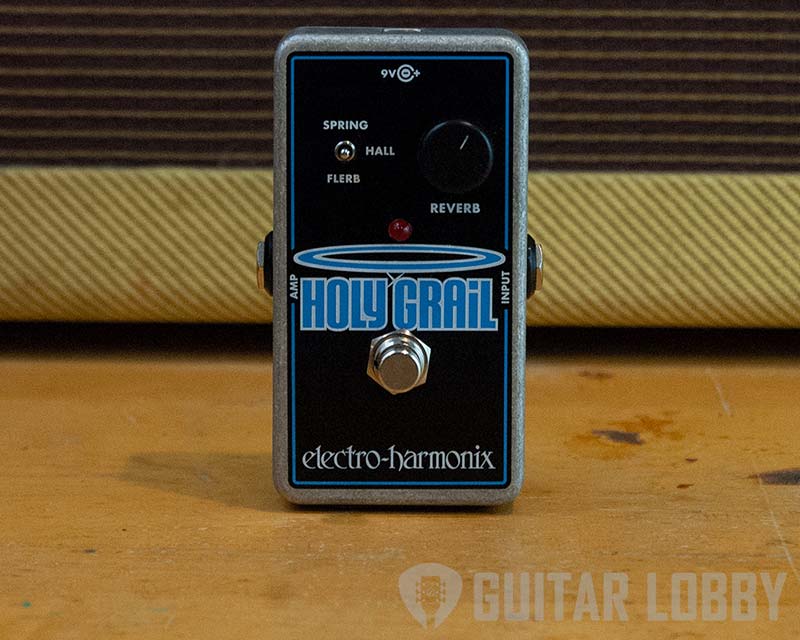
| Estimated Price | $140 |
| Power | 9VDC 100mA |
| Effects | Reverb |
| Connectivity | 1 x 6.35mm Jack Input, 1 x Output |
My Review: Electro Harmonix makes another appearance on our list, this time with the Holy Grail Nano. I just love how remarkably simplistic this pedal is, with no extra controls added just for the sake of it. Let’s get straight to the point. The Holy Grail Nano offers three high-quality reverb presets that can be alternated using the small toggle switch on the right of the pedal. Firstly, there’s a spring reverb that is sharp and reflective in sound. Then there’s the more ambient hall reverb setting that provides a more spacey, psychedelic vibe. Finally, there’s the interesting addition of flerb, which is a more wobbly variety of spring reverb.
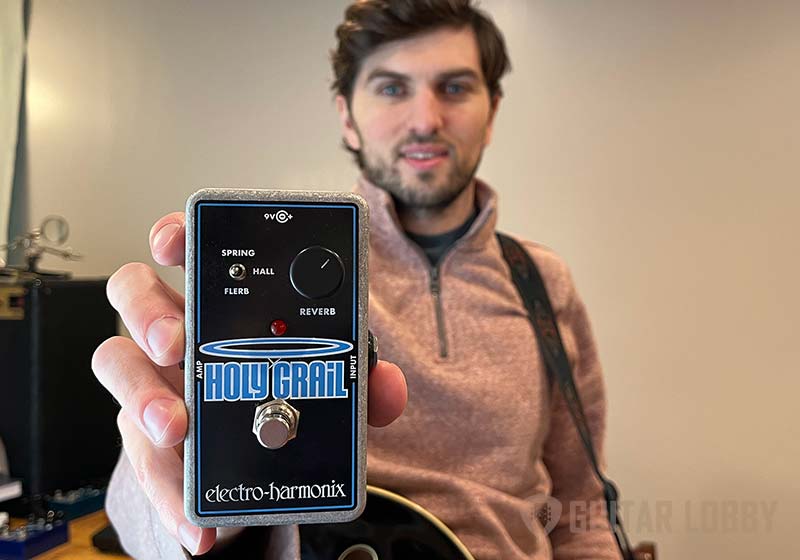
Once you’ve chosen your desired type of reverb, you can use the singular control knob to make the effect more or less prominent in the mix. Say, for example, you chose the hall setting; cranking the control all the way would produce a long-tailed, atmospheric reverb sound. If you dialed the control down, you would get a slight undertone of gloss added to your guitar output. With true bypass capabilities, there’s no danger of your tone suffering when the pedal is turned off.
This pedal has the minimalist in mind. If you’re the kind of guitarist who doesn’t want to spend valuable time setting up the various controls on an effects pedal, the minimalist design of the Electro Harmonix Holy Grail Nano will suit you to a tee. Its small dimensions make it easy to position on a busy pedalboard too.
You might think that $160 is expensive for a pedal that only offers the bare minimum in terms of controls and parameters. However, the Electro Harmonix Holy Grail Nano justifies its price tag by producing tones of pristine quality. In reality, there are still a good number of options provided by the trio of reverb settings and the control knob, so don’t be put off by the primitive design.
Bottom Line: Extremely straightforward design, this pedal has the minimalist kind of player in mind. It’s compact, well made, and it houses three high-quality classic reverb settings with a level knob.
| Name of Product | Image of Product | Description | Price Range | Full Review |
|---|---|---|---|---|
| 1. TC Electronic Hall of Fame 2 (Best Value) | 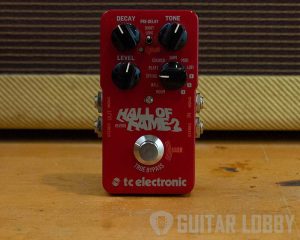 | Power: 9VDC 100mA Effects: Reverb | $160 | Read Full Review Above |
| 2. JHS Series 3 Reverb (Best Under $100) | 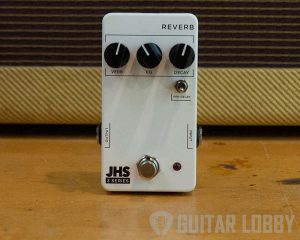 | Power: 9VDC 100mA Effects: Reverb | $99 | Read Full Review Above |
| 3. Keeley Caverns (Best Reverb + Delay) | 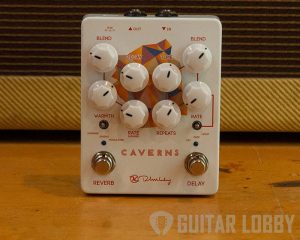 | Power: 9VDC 100mA Effects: Reverb + Delay | $200 | Read Full Review Above |
| 4. Empress Effects Reverb (Editor's Choice) | 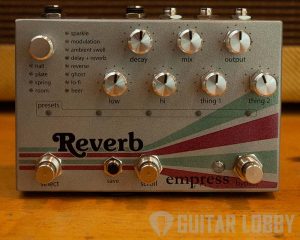 | Power: 9VDC, 300mA Effects: Reverb | $500 | Read Full Review Above |
| 5. Strymon BigSky | 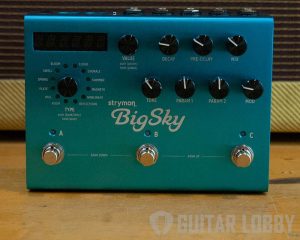 | Power: 9VDC 300mA Effects: Reverb | $500 | Read Full Review Above |
| 6. Walrus Audio Slo Multi Texture | 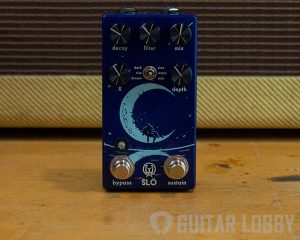 | Power: 9VDC 100mA Effects: Reverb, Modulation | $200 | Read Full Review Above |
| 7. Electro Harmonix Oceans 11 | 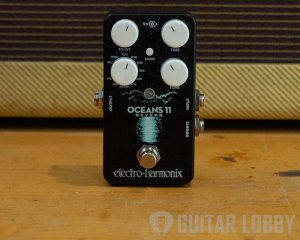 | Power: 9VDC 150mA Effects: Reverb, Tremolo, Modulation | $180 | Read Full Review Above |
| 8. Red Panda Context | 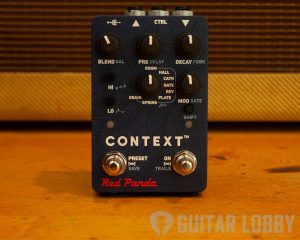 | Power: 9VDC 250mA Effects: Reverb | $330 | Read Full Review Above |
| 9. MXR M300 | 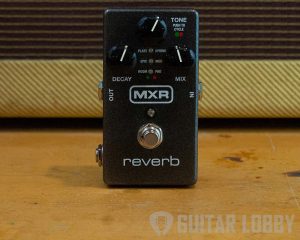 | Power: 9VDC 100mA Effects: Reverb | $220 | Read Full Review Above |
| 10. Walrus Audio Lore Reverse Soundscape Generator | 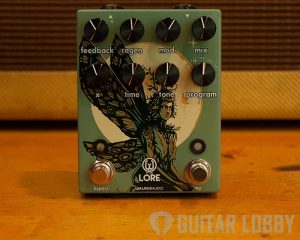 | Power: 9VDC 300mA Effects: Reverb, Reverse Delay | $299 | Read Full Review Above |
| 11. Walrus Fathom Multi Function Reverb | 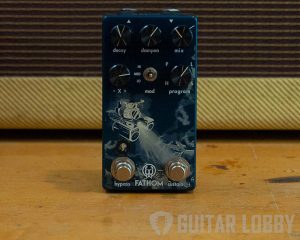 | Power: 9VDC 100mA Effects: Reverb | $199 | Read Full Review Above |
| 12. BOSS RV-6 | 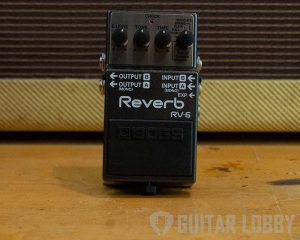 | Power: 9VDC 100mA Effects: Reverb | $170 | Read Full Review Above |
| 13. Electro-Harmonix Holy Grail Nano | 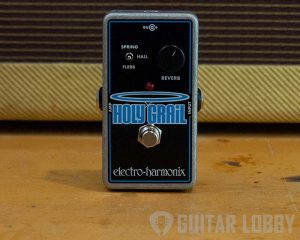 | Power: 9VDC 100mA Effects: Reverb | $160 | Read Full Review Above |
Choosing the Right Reverb Pedal (Buying Guide)
Distortion pedals come in a variety of shapes and sizes with differing capabilities and functions. Before choosing the best-suited addition to your pedal board, it’s important to understand what the various controls and specifications mean in relation to your guitar’s tone. In the following section, I’ll present a detailed overview of everything you need to know about distortion pedals so that you can make an informed choice.
What Is Reverb?
Reverb is, without a doubt, one of the most popularly used effects across all musical genres. There’s not an instrument that doesn’t benefit from at least a touch of reverb to make the sound friendlier to the human ear. Where guitars are concerned, reverb can completely transform your sound or add slight warmth to the tone. But what exactly is reverb, and why is it such a popular effect?
Technically speaking, reverb – which is short for reverberation, is the result of sound waves reflecting off a physical surface. The sound is then reflected and sent back to the human ear, with the reverberations coming so closely after the original sound that it is interpreted as one singular sound. Reverb is present not only in music but in all facets of everyday life.
You could say that reverb is the interaction between a sound and the materials, objects, or surfaces in its direct environment. For example, if you are in a large hall and clap your hands, the original sound would reflect off all the walls, and you would hear the sound of the clap interacting with these surfaces.
When we use reverb pedals, we are simply synthesizing this natural process using digital technology. The main reason that reverb is such a popularly used effect by guitarists is that it softens the decay of the sound, making it more ambient and adding thickness. Although the science behind reverb is pretty simple, there are numerous variations of this effect that can range from subtle to extreme. All of the variations of reverb are based on genuine naturally occurring sounds, reproduced, and programmed into an effects pedal so that you can control the type and amount of reverb on your guitar.
The Origins of Reverb In Music
One of the pioneers of reverb-draped guitar was Pink Floyd’s innovative guitarist David Gilmour. In the early days, when recording studios and music technology was in their formative period, there was no way to artificially produce reverb. Therefore, producers and guitarists like Gilmour had to create reverb intentionally using natural methods in order to make their tracks more spacey and resonant.
Back in those days, the type of reverb used was referred to as acoustic chamber reverb. To produce the effect, musicians would use the characteristics of a physical space to create a natural echo chamber. These echo chambers have been responsible for some of the most iconic guitar effects in music history, with each recording studio having its own unique chambers where variables such as decay time and reverb tone were purposefully created.
Usually, a reverb chamber is composed of dense materials like brick or concrete with layers of plaster on the inside. This combination of materials results in the midrange frequencies having a decay time of a number of seconds. The size of a reverb chamber directly impacts how quickly the onset of reverberation occurs. A smaller chamber produces colorful frequency responses and reflections, whereas a larger space produces more favorable acoustics.
Plate Reverb
The next development after echo chambers was plate reverb. Due to the cost of building a room, especially for reverberation, the invention of plate reverbs like the EMT 140 revolutionized the process for producers.
Plate reverbs achieve their desired effect by sending sound through a sheet of thin metal. As the metal vibrates, the sound is recorded by some pickups, mimicking the sound of natural reverb pretty convincingly. However, plate reverb has its own distinct sound that is warm in tone when picked up by a microphone.
Spring Reverb
Shortly after the first plate reverb unit was created, the spring reverb provided another alternative method. Instead of using a sheet of metal and capturing the reflections, this technique uses a spring that is much smaller than the materials needed for plate reverb. The two types of reverb share some sonic qualities, but the spring variety is more tinny and metallic in nature.
Around this time, many guitar amp manufacturers started to incorporate springs into their amplifiers. This gave guitarists access to reverb while on stage or recording. When the dry signal of the guitar passes through the springs inside the amplifier, it causes them to vibrate and produce an echo-like effect.
The Common Types of Reverb Found on Reverb Pedals
Now that we’ve touched upon the origins of reverb used in music recording, it’s time to look at the various forms that this effect is reproduced within a reverb pedal. Like all digital guitar FX, reverb pedals work by synthesizing the process electronically to produce a similar or identical outcome. There are numerous types of reverb used on these pedals, with some of the most common being.
- Hall Reverb
- Room Reverb
- Ambiance Reverb
- Cathedral Reverb
- Chamber Reverb
Hall or concert hall reverb is the result of a large space that has usually been designed with specific acoustics in mind. This produces a long decay time that is usually around 2 seconds, with some pre-delay built-in so that there is a slight pause before the earliest reflections occur. The bulk of the effect comes at the tail end rather than early in the sound, creating a spacey, distant type of reverb. Hall is commonly built into reverb pedals and sounds great on ballads or slow bluesy guitar solos.
Another variation commonly found on guitar pedals is room reverb. This refers to the effect that happens when a sound is played in a small space like a bathroom or living room. Although the reverb produced is less polished and intentional than that of a concert hall, room reverb has a familiar sound because it recreates the reflections that we are used to hearing when spending time indoors. The decay time of room reverb is generally short, at around ¾ of a second, and the early reflections are more prominent than the tail end.
Ambiance refers to a type of reverb that has a very short decay time. In fact, the tail is so short that it is hard to hear without focusing on it specifically. Ambient reverb is more focused on the early reflections and doesn’t alter the original sound too much. It’s basically a middle ground between room reverb and no reverb at all, with very little alteration to the character of the sound source. Despite its very subtle effect, it is commonly found on reverb pedals because it smoothens out the tone without drawing attention away from a guitarist’s playing.
A cathedral preset can also be found on most reverb pedals. This type of reverb has a longer, more prominent effect than hall does. As you can guess by the name, it is based upon the acoustics of a large cathedral with highly reflective materials that are usually shaped like squares or triangles. This produces a long decay time, reaching anywhere up to ten seconds before the sound dies out. Cathedral reverb sounds thick and chaotic as the numerous tones merge over a long decay time. It is highly effective for playing dreamy guitar melodies and creating warmth within the mix.
We’ve already covered chamber reverb and how it was initially produced, so I won’t repeat myself here. It’s worth noting, however, that chamber reverb is a staple of guitar pedals because the original form was used on so many iconic recordings that many guitarists strive to replicate this natural effect. Thankfully, reverb pedals allow us to do that without having to hire out Abbey Road Studios for the day! Learn more about the types of reverb here.
Common Controls on Reverb Pedals
On a reverb pedal, you’ll find that there are several adjustable parameters that allow you to control different aspects of the effect. Although these controls may seem complex at first, when broken down, they’re quite easy to understand. The main parameters found on a reverb pedal are
- Pre-Delay
- Decay Time
- Dry/Wet amount
- EQ
The pre-delay control on a reverb pedal affects the amount of time it takes for the input signal to reflect off the surface, then return to your ears. In a natural environment, the original sound is made, then there is a period of time when the soundwaves are traveling to the surface. When this control is turned up, it will recreate the predelay of a larger room and vice versa.
The Decay parameter controls how reflective the room is. It is the amount of time that the reverberations carry on after the original sound has come into contact with the surfaces. If you were to crank this control on a delay pedal, it would simulate a larger, more reflective room.
The Dry/Wet amount is pretty self-explanatory. Sometimes, you won’t want to completely drown your guitar in reverb, as this can make it sound muddy and chaotic. A good way to combat this is by finding your desired reverb sound by tweaking the pre-delay, decay, and EQ settings, then adjusting the wet/dry control to choose how much of the effect is present in your overall mix.
EQ settings are commonly featured on reverb pedals. This is a highly useful control as it allows you to shape the frequency response of the effect to make it blend nicely with your guitar’s natural tone. By cutting off problem frequencies or unwanted bass traps caused by a reverb pedal, you can create smoother, cleaner tones accurately.
Tempo-Syncing Your Reverb Pedal
A great way to make reverbs more compatible with the other elements of a song is by adjusting the individual settings until the tempo is synchronized. This is especially useful if there are multiple instruments in a band using reverb at once. When they are all out of sync with each other, the reverb can become messy and interfere with the groove of your playing.
Unlike delay pedals which sometimes come with a tap tempo function to simplify the process, tempo-syncing a reverb pedal requires more manual work and calculations. Thankfully, it’s not too complicated, and once you’ve memorized the method, it will become second nature.
Some reverb pedals allow you to adjust the pre-delay to be a certain note value, for example, 16th notes. The decay time could be adjusted to whole notes or half notes, depending on the tempo of the song. This is a simple way to tighten up the tempo of your reverb pedal, but it’s not the most accurate.
Many reverb pedals present values in terms of ms (milliseconds). In order to synchronize the reverb to your desired tempo, you need to convert the note values into milliseconds. This is where it can get a little complicated but stay with me here. Basically, a quarter note, half note, or whole note will be valued differently in milliseconds depending on the tempo of your track. For example, a quarter note would equate to 600ms if your song was at 100BPM or 461.54ms if the tempo was 130BPM.
There are many online calculators and apps that will work this out for you so that you don’t need to spend time figuring the settings out for each individual song.
Positioning a Reverb Pedal In The Signal Chain
After selecting the right reverb pedal to add to your pedalboard, the next question that arises is where it should be positioned in the signal chain. In reality, there’s no correct answer. In many cases, the most unique and interesting guitar tones are a result of experimentation and going against what is considered to be the norm. With that said, there is some theory behind the positioning of your reverb pedal, which will greatly impact the sound it produces.
More often than not, guitarists will position time-based effects like reverb and delay at the end of their signal chain. The reason for this is that reverb provides color to the signal and is usually set to certain timing. By adding this effect last, all of the other pedals in your signal chain will be affected by its presence. It sounds less messy if you add a reverb to an overdriven signal rather than distorting the reverb. Because reverb creates a number of tones and reflections, adding other effects to it subsequently will amplify the inconsistencies of the sound.
Dual Output Reverb Pedals
You might have noticed that some of the aforementioned reverb pedals in this article come equipped with two outputs. This isn’t a necessity, but it can be a useful tool, especially if the style of music you play requires the guitar to maintain a certain level of thickness in the mix.
A common issue for guitarists is that when they activate effects pedals, the overall tone can become weaker and less full-bodied. By utilizing dual outputs, you can split the signal and send the dry output into a separate amplifier to the effects channel.
This allows the unprocessed sound of your guitar to play underneath the effects, ensuring that the overall tone remains thick and consistent. If you would like to use two amplifiers to achieve this, look out for two jack outputs on the right-hand side of a pedal.
Shimmer and Gated Reverbs
Along with the staple varieties of reverbs that you will usually find on a pedal, some are capable of producing mechanical reverbs that have been subjected to processing.
Shimmer is a bright-sounding reverb that gets its tone from being processed by pitch shifters. The actual reverb itself can be from any setting, but it sounds unique after being shifted up an octave to emphasize the higher frequencies.
Gated reverb has similar coloration to room reverb but differs in the length of decay time. The signal is passed through a noise gate that cuts off the tail before it naturally decays. By gating the reverb, you get complete control over its rhythmic nature, and you can create arpeggio-like patterns using this effect.
Reverb for Vocals
Using guitar pedals for vocal processing is generally not recommended because they usually create feedback and unwanted noise. However, you can get some interesting results by using a reverb pedal on vocals. By plugging a microphone into the input via an XLR/Jack adaptor cable, you can experiment with the different varieties of reverb on your voice and create psychedelic sounding vocals tracks.
Power Requirements
The majority of the reverb pedals reviewed earlier in this article require 9V DC power. In most cases, this can come from a power supply or a 9-volt battery. Having a fresh set of batteries in your pedal will prevent the dreaded cut-out from occurring if your power supply malfunctions on stage.
It’s important to consider making sure you don’t attempt to power your pedal with too high of voltage for what it’s rated and to also verify the polarity of the supply you are using. Using a power supply with too high output voltage or wrong polarity could potentially damage your pedal.
Current requirements are also important to consider. You’ll need to make sure your power supply is capable of outputting the minimum amount of current required by the pedal. The pedal draws current from the power supply, so unlike voltage, you want to ensure you meet at least the minimum input current rating of the pedal with your power supply. For example, some of the pedals ranked above require 300mA, which is relatively high for a single pedal. On a typical power supply, you might see outputs for 100mA, 250mA, 300mA, 500mA, etc. these are maximum values, meaning this is the maximum amount of current the pedal can potentially “pull” out of that supply. So if your pedal needs a minimum of 300mA, it can draw enough from a supply output of 300mA or higher.
Power supply requirements should be a decision-making factor for buyers as they are a key parameter in how the product is designed. While pedals with higher output power requirements make it possible for more dynamic range and headroom, it can also be a parameter that exceeds many players’ needs and create an unnecessary inconvenience and cost. Many pedals are designed to function with a simple 9V battery or a 9VDC 100mA power supply port. If you start to purchase pedals with higher power requirements, you will inevitably need to consider purchasing a power supply with more outputs and higher output capability.
Time to Experiment
Once you’ve decided on the best reverb pedal for your needs, it’s time to enjoy hours of experimenting with the settings to find your desired sounds. Reverb is one of the most fun effects to play around with simply because of the endless possibilities it provides. You might find that certain types of reverb suit the neck pickup of your guitar or that other varieties are best suited to fingerpicked styles of playing. Whatever your aim is, it’s inevitable that you will find some unique sounds to take your guitar playing to another level.
If you’re looking for a high-quality reverb pedal, look no further! I have tested dozens of them and compiled a list of my favorites at all price points.

My name is Chris and I’ve had a passion for music and guitars for as long as I can remember. I started this website with some of my friends who are musicians, music teachers, gear heads, and music enthusiasts so we could provide high-quality guitar and music-related content.
I’ve been playing guitar since I was 13 years old and am an avid collector. Amps, pedals, guitars, bass, drums, microphones, studio, and recording gear, I love it all.
I was born and raised in Western Pennsylvania. My background is in Electrical Engineering, earning a Bachelor’s degree from Youngstown State University. With my engineering experience, I’ve developed as a designer of guitar amplifiers and effects. A true passion of mine, I’ve designed, built, and repaired a wide range of guitar amps and electronics. Here at the Guitar Lobby, our aim is to share our passion for Music and gear with the rest of the music community.
